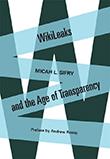 Sifry, Micah - WikiLeaks and the Age of Transparency, OR Books, New York, 2011 (224 pp) ISBN-10: 1582437793
Sifry, Micah - WikiLeaks and the Age of Transparency, OR Books, New York, 2011 (224 pp) ISBN-10: 1582437793
We are at war. It is a covert operation, waged largely under the radar of the mainstream media, but the endgame is nothing less than revolution. Welcome to the ‘Age of Transparency’, an era in which hackers ‘attack’ the websites of alleged wrongdoers and leakers of government information can be charged with aiding the enemy. It sounds fantastic, but Micah Sifry’s “report from the trenches”, WikiLeaks and the Age of Transparency, is a chronicle of today.
Sifry co-founded the Personal Democracy Forum in 2004; originally an annual conference, it is now a year-round network for the transparency movement. He is also a founder of the Sunlight Foundation, a non-profit organisation devoted to open government policy and the development of technological tools for accountability. It is a body of work that allows Sifry to claim Julian Assange as a contemporary.
Assange and WikiLeaks were front-page news last year when the organisation began the systematic release of diplomatic cables amid a storm of press coverage. Dedicated observers will recall the release of Assange's collateral murder video, a military tape of US helicopters firing on Iraqi civilians. Since then there's been reams written about Assange, his motives, and what his methods mean for government and the media. Sifry defines a useful three-phase framework for the analysis of the WikiLeaks project. The first, between 2006 and 2009, is when the site simply processed information dumps, the second phase is when it began exercising editorial control over that material, and the third when WikiLeaks began to negotiate the release of its information via mainstream media.
But Sifry traces transparency efforts beyond WikiLeaks, specifically to 4.31 pm on April 23, 2003. This is the exact time and date that blogger Matthew Gross, working on Howard Dean’s campaign for the US presidency, started an “ask the Dean” campaign thread on an online political forum. Sifry argues that this post was the beginning of a “bottom up” revolution of people connecting and collaborating with each other for larger political aims.
He explains the revolutionary changes in the economics of information, connectivity and time that have made this possible. Information today is no longer reliant on print and paper, instead it can be shared instantaneously with the touch of a button. And networks are now “many to many” (42), freed from the limited number of relationships a single person or organisation can maintain. In parallel, the physical limits of space have exploded with the internet’s infinite capacity to store content.
Sifry calls this new environment the “Age of Transparency”. It is here, he says, “Not because one transnational online network dedicated to open information and whistle-blowing named WikiLeaks exists, but because the knowledge of how to build and maintain such networks is now widespread” (8).
WikiLeaks and the Age of Transparency is a potted account of this power shift in who controls and manipulates information. One example is a crowd-sourced mash-up of data and maps that was initially used to report casualties in conflict zones. Its application has now spread to everything from fixing street signs to the disclosure of bribe payments. Sifry points out that because of the spread of technology and know-how, grassroots organisation around common goals is now virtually effortless.
Sifry is a proud parent of the burgeoning transparency movement. Some of the significant events he describes at geek conferences are those that only a fellow techie could love, and sometimes his enthusiasm for the material appears to be overly personal. But his insights into Assange’s personality, scarce as they are, are well worth reading. The impression he presents of Assange is that of a dedicated, but paranoid, activist. On one occasion, Sifry describes meeting Assange, an invited guest at a conference in Barcelona. He and a colleague had to spend hours convincing a suspicious Assange that the conference organisers had a benign relationship with the US government, despite their acceptance of funding for travel costs from the US embassy. Sifry describes the efforts of those who have left the WikiLeaks organisation to set up other ‘leaks’ organizations without the “autocratic control and (Assange’s) personal problems”. In one reported email exchange, Assange writes to a disgruntled supporter: “I am the heart and soul of this organisation, its founder, philosopher, spokesperson, original coder, organiser, financier and all the rest ... If you have a problem with me, piss off” (158).
Sifry pays tribute to Assange’s success in creating a “stateless news organisation”, freed from the media’s corrupting links to government. But he stops short of endorsing Assange’s stated aims. He hints that Assange is on a deeply radical mission, not of improving government, but of creating a situation where it is, “impossible for ‘the conspiracy to think, act and adapt’” (160). Sifry’s own goal, of opening up powerful institutions and making them more accountable, is modest by comparison.
Which faction of the transparency movement will win the war remains to be seen. And we do not yet know whether Sifry’s conflation of the transparency movement with WikiLeaks is an enlightened vision or hopeless idealism. There are many questions to be asked about what effect transparency will have on the way bureaucracies deal with information, how governments communicate with their people, and how journalists navigate the responsibilities we have to audiences and sources. In the meantime, Sifry has written a valuable field guide to a dawning Age of Transparency.
About the Reviewer
Xanthe Kleinig got her first job as a journalist reporting for a country newspaper in South Australia and has since worked for News Ltd in both Adelaide and Sydney. She currently works for the ABC.

